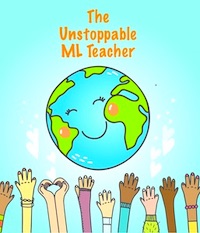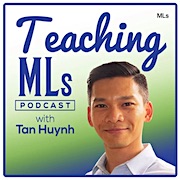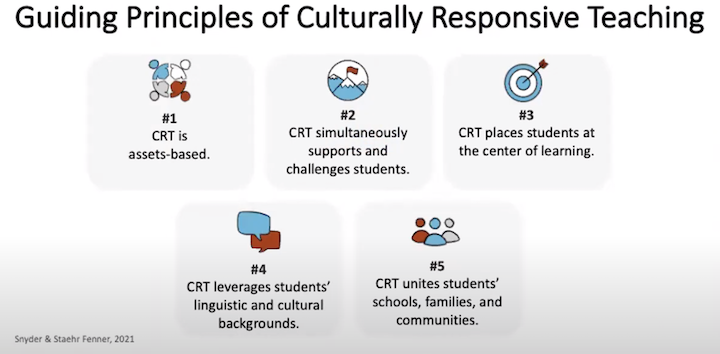5 Principles of Culturally Responsive Teaching
A MiddleWeb Blog
 There’s a rising wave of discussion around culturally responsive teaching (CRT). The goals of CRT (Hammond, 2014) are to:
There’s a rising wave of discussion around culturally responsive teaching (CRT). The goals of CRT (Hammond, 2014) are to:
● Improve the learning capacity of diverse students.
● Center instruction around the cognitive aspects of teaching and learning.
● Build resilience and an academic mindset by providing pushback against the deficit narratives about students of color.
Many of us, myself included, have never participated in coursework on this topic, yet it is so crucial to providing an equitable learning experience for multilinguals (MLs). Teachers can develop culturally responsive instruction by incorporating into their lesson design five guiding principles, which come from Dr. Diane Staehr Fenner and Dr. Sydney Snyder’s 2021 book entitled Culturally Responsive Teaching for Multilingual Learners (Corwin).
Guiding Principle 1: CRT is assets-based
The way we see students determines the way we teach them. With a deficit perspective, we are handcuffed by what we think students can’t do. From an assets viewpoint, we are free to think of all the things multilinguals can do. One way to be strengths-based is to build on students’ linguistic and cultural backgrounds. If multilinguals come from an oral-language tradition, we can incorporate stories. If they come from a community-oriented culture, we can design learning using collaborative structures.
Guiding Principle 2: CRT simultaneously supports and challenges students
If learning is to be equitable for multilinguals, then they must be given access to grade-level curriculum. When I first started teaching MLs, I would scoff at teachers who wanted the multilingual students to learn the same content as their peers. I would think, “How can this teacher expect students to learn about fair trade when they can’t even read the words ‘fair trade’?” In my pull-out sessions, I would ignore the teacher’s content and start by teaching them colors of the rainbow, school supply items, and farm animals.
Reflecting back, I am horrified by how I watered down the curriculum for my students. By doing so, I was widening the achievement gap. Now I have come to realize that multilinguals can and must learn the same content as their grade-level peers (Echevarría et al., 2017).
Guiding Principle 3: CRT places students at the center of learning
This principle is about instructional design. When designing learning, create experiences where students are required to do the heavy cognitive work of learning and manipulating both content and language. Ways to do this include collaborative structures, inquiry-based learning, problem-based learning, concept-based learning, and service learning.
All of these approaches to lesson design see students as active participants in their learning because when designed well, learning is the by-product of engagement.
Guiding Principle 4: CRT leverages students’ linguistic and cultural backgrounds
When we can link the content that we are teaching to what students are already familiar with, there is a firm foundation on which to build new learning. For example, when I taught a unit about world religions, students had to learn about the common characteristics of established belief systems. On the first day of that lesson, I had students sit in same-religion groups to identify the features of their own faiths. Starting off with what they know about their spirituality was a low-risk way to learn the content.
Guiding Principle 5: CRT utilizes students’ schools, families, and communities
Gone are the days when we taught in silos. Now it’s time for us to reach within and beyond schools to partner with all of the stakeholders in students’ lives. For example, we might invite families or community members representing the different faiths found in students’ communities into school to share their values.
Students’ family members and community guests can provide firsthand knowledge of the content and add a level of relevance to learning. It would be a pity not to collaborate with them on our religion unit, for example. When we take advantage of these resources, we have the added benefit of students, families, and community organizations feeling like they are also valued members of the school.
Culturally Responsive Teaching is here to stay
CRT is not a fad. It’s not one more thing we have to do for multilinguals. It’s a way of being with MLs and their families that is grounded in the assets of multilingual students, their families, and their communities. By our holding high expectations of MLs while providing high support, they can be both successful in school and proud of their heritage.
Which of these guiding principles are you most excited to start with in your context?

Diane Staehr Fenner and Sydney Snyder share the
five principles of culturally responsive teaching
with Tan Huynh
References
Echevarría, J., Vogt, M., & Short, D. (2016). Making Content Comprehensible for Secondary English Learners: The SIOP Model (5th ed.). Pearson.
Hammond, Z. (2016, October 20). Culturally Responsive Teaching & The Brain. The Teaching Channel (Corwin Book)
Snyder, S. C., & Staehr Fenner, D. (2021). Culturally Responsive Teaching for Multilingual Learners: Tools for Equity. Corwin.




































